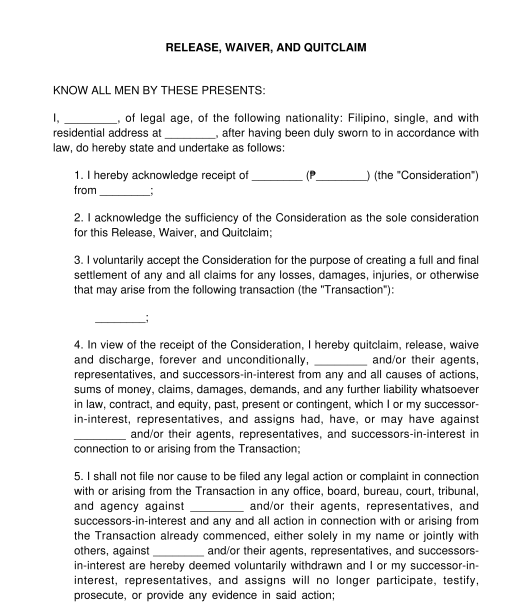 09/10/2025
09/10/2025

Answer a few questions and your document is created automatically.

Your document is ready! You will receive it in Word and PDF formats. You will be able to modify it.

 09/10/2025
09/10/2025
 Word and PDF
Word and PDF
 2 to 3 pages
2 to 3 pages
What is a Release, Waiver, and Quitclaim?
A Release, Waiver, and Quitclaim is used when one party (the "Releasor") is releasing another party (the "Released") from any liability or obligations connected to or arising from a specific transaction, meaning the Releasor will not run after the released to pay, do, or give something. This is usually given by the Releasor to settle a dispute between the Parties, such as when the Releasor is alleging that the Released is liable to the Releasor for some reason.
Without actually admitting any liability, a Release, Waiver, and Quitclaim, signed by the Releasor releases the Released from all liabilities connected to the specific transaction for which the Release, Waiver, and Quitclaim was signed. In return, the Released may agree to provide some kind of compensation to the Releasor. This compensation is usually in the form of money but other goods and services may also be used as compensation.
Once a Release, Waiver, and Quitclaim is signed by the Releasor, the Releasor gives up the right to claim anything from the Released.
The following are the different types of Quitclaims:
Is it mandatory to have a Release, Waiver, and Quitclaim?
There is no legal requirement to have a Release, Waiver, and Quitclaim but this will serve as a protection on the part of the Released against possible claims that the Releasor may bring to the courts against the Released by reason of the transactions or dealings between the Releasor and the Released.
Who signs a Release, Waiver, and Quitclaim?
The Releasor must sign a Release, Waiver, and Quitclaim. Note that the Releasor must be of legal age to be able to sign the document.
What has to be done once a Release, Waiver, and Quitclaim is ready?
Once the document is completed, at least three original copies should be printed, then the Releasor should read the document and sign all original copies of the document. To notarize a document, the Releasor must personally appear before a notary public to acknowledge that they have voluntarily signed the document and that they signed the document as their free and voluntary act and deed. The Releasor must also present competent proof of identification that was issued by an official agency bearing the photograph and signature of the principal.
Which documents should be attached to a Release, Waiver, and Quitclaim?
If a representative will sign for the Releasor the following should be attached:
Is it necessary to notarize a Release, Waiver, and Quitclaim for it to be valid?
Yes, because a Release, Waiver, and Quitclaim is a sworn statement that should be executed or signed in the presence of a notary public. If it is not notarized, there may be a risk on the part of the Released that the Releasor will run after him and pay, do, or give something.
What are the costs involved in the finalization of a Release, Waiver, and Quitclaim?
Notarization fees for a Release, Waiver, and Quitclaim are typically PHP100 to PHP500.
What must a Release, Waiver, and Quitclaim contain?
A Release, Waiver, and Quitclaim should contain the following information:
Which laws are applicable to a Release, Waiver, and Quitclaim?
There are no laws that apply specifically to a Release, Waiver, and Quitclaim however, the general laws on obligations found in the Civil Code of the Philippines may apply. Further, acknowledgments are governed by the 2004 Rules on Notarial Practice. It should also be noted that making untruthful statements in a notarized document may be punishable under the Revised Penal Code of the Philippines.
You fill out a form. The document is created before your eyes as you respond to the questions.
At the end, you receive it in Word and PDF formats. You can modify it and reuse it.
Guides to help you
Release, Waiver, and Quitclaim (One-Way) - template
Country: Philippines